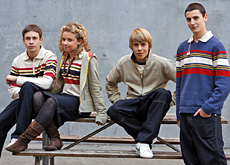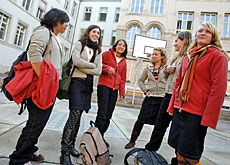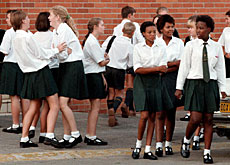Trendy uniforms fail to appeal to students

A pilot project to introduce school uniforms at a Basel secondary school will be stopped after a six-month trial period because the clothes proved too unpopular.
Students will now revert to their usual gear, but another attempt at uniforms will be made during the next school year with younger pupils, using a simpler set of clothing.
The experiment, which was keenly watched across Switzerland, where students do not usually wear uniforms, was aimed at measuring how the clothing affected pupils’ performances, identities and spending habits.
But the clothes were apparently not classic enough for their taste.
Two classes of 14- to 15-year-olds at the state-run Leonhard school in Basel took part in the experiment, wearing a mix-and-match uniform drawn from a 14-piece collection of different items.
The collection was chosen by a jury, which included pupils. Drawn up by local designer Tanja Klein, it includes trainers, three-quarter length cargo pants, hooded tops and beanie hats and was supposed to be suited to teenagers.
However, it was somewhat different from what most people – especially in other countries – consider to be a school uniform: dark trousers or a skirt, a white shirt, a tie and a blazer for example.
The students were not against wearing a uniform as such – they just found that it was not classic enough, according to the school’s director, Christian Griss.
Pupils felt the smart-casual outfit did not suit their style, and would have rather gone with something more traditional, along the lines of school clothing worn in Britain, he added.
Unsurprising
Alexander Grob of Basel University’s psychology institute, who is conducting an external evaluation of the project, says this is not surprising.
“I think they like to show they belong to the same group,” he told swissinfo. “If they wear the same sweater or the same trousers for example, they are identifiable for their friends and it says they come from the same school.”
However Griss said he was not sure that classic clothing would be more successful. “I don’t see these youngsters running around in a blazer,” he told the NZZ am Sonntag newspaper.
The pilot project was aimed at finding out what students were prepared to wear, but the school director says that while the style question has now been debated, no decision has been reached on whether uniforms were a good or bad idea.
There is no tradition of school uniforms in Switzerland. Various cantonal parliaments have spoken out against the idea, rejecting it on the grounds that it either did not suit the cultural environment or would hinder a child’s personal development.
Branded clothing
One of the reasons school uniforms have been proposed is that it would allow students to break away from peer pressure and the need to purchase branded clothing.
The uniform in the pilot project costs around SFr730 ($592), but parents only paid SFr100, with the rest covered by sponsorship, including that of the Swiss Textile Association.
But it is estimated that purchasing a uniform would usually work out 30 per cent cheaper than buying the same amount of clothes.
The Leonhard school management still wants to press on with the uniform project, although this time with a younger group and fewer clothes to choose from. For Grob, the plan is more likely to meet with complete acceptance.
“The sooner you introduce a uniform the more accepted it is by the pupils,” he said.
The jury still out on whether school-sanctioned clothes help improve students’ marks. This will take more time, according to Grob.
“We have indications from other projects that performances increase,” he told swissinfo. “But it takes at least one to two years for an effect to be noticeable.”
swissinfo, Scott Capper
More and more young people are caught up in the consumption of status items such as clothes, mobile phones and electronic equipment.
Experts estimate that Swiss children and young people have a total of at least SFr600 million pocket money at their disposal per year.
In a survey of 1,000 young people, 760 of them said they would be prepared to get into debt.
As a general rule, school children in Switzerland do not wear uniforms.
Only some private schools, with students from abroad, impose student attire.
School uniforms dominate in Britain, Ireland and Cyprus.
In the United States school uniforms are fairly common at private schools, but not state schools.
Outside Europe they are the norm in Australia, New Zealand, South Africa, Japan and many former British colonies.

In compliance with the JTI standards
More: SWI swissinfo.ch certified by the Journalism Trust Initiative


You can find an overview of ongoing debates with our journalists here. Please join us!
If you want to start a conversation about a topic raised in this article or want to report factual errors, email us at english@swissinfo.ch.